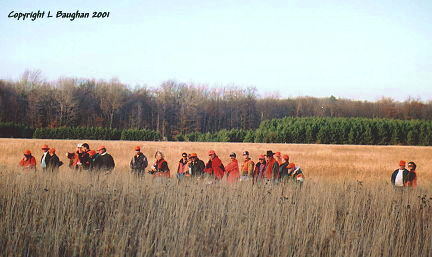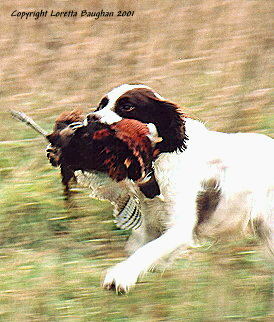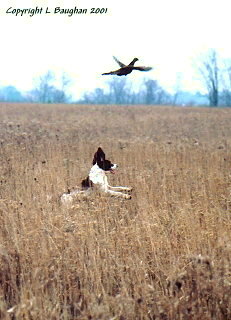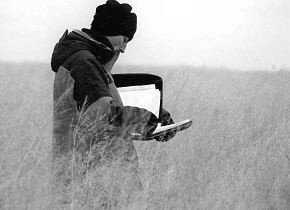  Hi again, folks.
I would like to sincerely thank that group of people who
wrote in after my first article. My friends and training mates were very
supportive, and that was encouraging to see. But just as important was the
folks who don't know me who had some really good questions, observations,
and comments about specific field trial situations and/or the last article
in general. Many good points were raised and I will do my best to address
them here in this article.
Several comments related to new people in the field trial world. Let's
discuss some of these topics first.
It was asked if there is any sort of "entry level field trial". Yes and no. Actually written
into our Field Trial Guidelines book (the little blue book that explains all the AKC regulations
governing field trials) are the provisions for Limit and Novice stakes. We
don't see them anymore in the states as we don't have time on a given
weekend to do them. In Canada, we still occasionally see Limit stakes. These
are stakes in which dogs of any age can run - if they haven't had an All-Age
field trial placement. So, if your hunting dog is steady, you can run him.
Typically, these stakes do little more then replace the puppy stake on a
given trial day as most folks just run their young dogs in the Limit.
The puppy stake - both here and in Canada - is where most folks get their feet
wet. In a puppy stake, dogs of up to two years of age may compete. They must be
steady. Almost always, pigeons are used. Dogs are run individually; just you,
two guns and two judges with a gallery walking behind. It can be a bit
nerve racking for first time handlers, but it is a good way to start.
"Have fun with your dog and enjoy meeting the other contestants and their dogs."
A step down from puppy stakes are fun trials. These things can be fantastic
though hard to find. In a fun trial, local clubs will hold a trial-like
competition. It is not AKC sanctioned at all, just a simulation of a trial
where club members can compete on an informal basis. In Wisconsin, we have a couple
every year. Minnesota has a small fun trial circuit each summer where several
clubs all have events on different weekends. I'm sure there are others
scattered around the country. It is a very fun way to meet new friends, see
new dogs and get your feet wet at running a trial.
The next closest thing are hunt tests. I personally love the idea of hunt
tests; they are fabulously conceived. Their drawback is that at times their
execution is lacking. We'll get to that in a moment. First, let's talk about what they are. At a
hunt test, your dog is not competing against other dogs, but is trying to
perform up to a written standard. There are three basic levels of hunt
tests: junior, senior, and master. Basically, a quick summary of each level
would be that in the junior your dog has to run around a bit, find a couple
of game birds (normally pheasants, sometimes chukars), flush them, then
bring them to your general area after they are shot. Then they need to do a
single short water retrieve. In the senior, the dogs need to be able to be
quickly called off of missed game, need to be line steady at the water for a
single short retrieve, and need to do a short land blind on a dead bird.
Birds need to be delivered to hand. In the master, dogs need to be steady to
birds on land and in water plus do a water and a land blind on dead birds. In
all stakes, the two judges are only there to determine whether your dog did
or didn't do these actions that are spelled out in a book.
At a hunt test, if all the dogs entered do well on a given day, then they all
get ribbons. That is very cool. It is also a great place to practice running
your dog while having a group of people watching you. That isn't for
everyone and it can take some getting used to. The tests are an excellent
way for people who have a hunting dog to get involved with other people who
also love their dogs very much. There is not the pressure of a trial at a
hunt test, it is a more relaxed atmosphere and a good place to go that doesn't
have the competitive atmosphere of a field trial.
But there is a dark side. Generally, the judging at spaniel hunt tests is highly erratic.
Amazingly so - considering how well the rules are spelled out in the
guidelines. Peoples interpretations of the rules laid out before them can
be breathtakingly devoid of any common sense. For this reason, many of the
field trial folks stay clear of hunt tests. Many of the hunt test people are
just fine with that as they feel that many field trial folks judge far to
strictly, thereby making it harder to pass a given test. The end result is that
a lot of very good, experienced, and knowledgeable people hold hunt tests in
low regard.
As this petty bickering goes on, nothing is being done to
promote the sport of spaniel hunt tests. It has actually shrunk a bit
instead of grown over the last decade. That is most unfortunate as it really
is the perfect venue for most folks and their dogs. My advice to anyone
interested in hunt tests is to go visit one and learn what they are about.
Then go and run your dog. Have fun with your dog and enjoy meeting the other
contestants and their dogs. Don't get too worked up if things don't go your
way at them - just enjoy your time in the field with friends of two and four
legs.
"...you have to figure it out from the dog's point of view, not yours."
Okay, enough hunt test talk, back to the original novice handler topic.
It was also pointed out that it is very difficult for new handlers to learn all
the things they need to know at a field trial. That is very true and I would
add to that point that it is experience that helps more then anything else.
New handlers try and think their way through situations. That gets them into
trouble as often things develop faster then a person can reason them out.
Once you have experience, you will be able to make snap judgments in a very
fast reactive manner. The best thing to do will just come out of you in less
time then it would take you to think about it. (I feel quite certain that
many of my closest friends would whole-heartedly agree that I rarely think
about things - actions and words just seem to come out of me!) Anyway, as you
gain experience, decisions will become more instinctive for you. It is your
job as a handler and trainer to take full advantage of your experiences.
After each trial, and for that matter, each training session, sit down and
figure out what happened. Remember, the good things as well as the bad
things. Try to figure out why things went the way they did so that in the
future you will be more able to recreate the positives and eliminate the
negatives. Some folks keep journals. I tried that but found that I spent too
much time writing about stuff and not enough time figuring out why stuff
happened. But you need to use whatever method works best for you.
Here is the key thing to remember while you are figuring out what happened
to you and your dog: you have to figure it out from the dog's point of view,
not yours. It is easy to understand that what went wrong was that your dog
ran left when you pointed right. It could be your fault that you pointed the
wrong way or it could be the dogs fault for not going where you wanted him
to. Figure out why the dog did what he did. When figuring that out, remember
that a dogs primary source of information is its nose. That is very hard for
people to understand as it is generally a very weak sense for us. Decide why
a dog performed in the manner it did then make changes to correct it so it
doesn't happen again. That may mean different handling on your part or
different or further training for your dogs part. Don't allow yourself or
your dog to make the same mistakes over and over again. Learn from them, fix
them, and move on.
So, let's move on to one of those mistakes that is often made which was the
topic of a very good e-mail from an experienced field trial competitor and
judge. It is the issue of pointing. Specifically, "flash pointing" or
"stop, look, and listen" for the bird. ("SLL" he called it, which makes it sound
like a disease of some sort - which I suppose is rather fitting.)
We spoke in the last article about having fast, positive finds. Judges like those.
Judges do not like slow deliberate finds. Also, judges do not like to see dogs
stop and listen for a bird or look for movement when they can't find a
bird. Often birds will be buried in under cover and some dogs will use other
senses besides their noses to find the birds. Some dogs are more genetically
inclined then others to do this. Some dogs are encouraged by their training
to do this.
The idea behind a spaniel having a fast flush is to force game into the air
as fast as possible, before it has a chance to escape on foot. Stopping and
looking could give a bird a chance to escape. That makes sense to me to a
point (pun intended). I do, however, see some dogs that are very good at
trailing birds but will lock up when the bird is hiding right in front of
them. That looks bad from a field trial standpoint certainly, but most folks
who hunt don't care about that at all.
I personally feel that in field trials we want a dog that is moving all the
time, not stopping when it loses scent. When I am judging I take the whole
weekend into account. I see what the other dogs are doing and what
extenuating circumstances there might be for the dog that had a bunch of
great finds and one bad one. I don't like throwing dogs out for a single bad
find. Birds are just too unpredictable to punish dogs like that. Remember, in
trials we are looking for the best of the best so we do need to reward the
strong flushes. That being said, often what happens is the dog with the
super flushes is also the dog with the control issues. In that case, I might
like the dog that stopped once or twice for a very short time but ran very
kindly for his handler a little better the dog that blew birds out while the
handler was screaming through the whistle the whole time. I guess as far as
judging, it really is one of those personal decisions that must be made in
the context of a given weekend's conditions.
So how do we prevent it from happening to our dogs? Some dogs you don't. But
with most dogs it is not too big of a deal to fix or just prevent it from
happening in the first place. You must take away a dogs ability to use its
senses of sight and sound. Make him use his nose. Do some night training -
especially on windy nights. I have heard of guys taking Doggles (little
doggy safety goggles) and coloring the lenses so the dog can't see well. I
haven't tried that but I would think one would need to use a bit of common
sense with that so your dog didn't run into a tree and break it's neck.
I often will use dead and/or taped live birds. These are birds that won't move
at all. The dog can stop and look all it wants, but nothing will happen
until he follows his nose right until it touches feathers. Don't use
wing-clipped birds as that will make things worse. That will encourage a dog
to use their nose and eyes to find them... the exact opposite from
what you are trying to do.
"The idea behind a spaniel having a fast flush is to force game into the air as fast as possible, before it has a chance to escape on foot."
For problem dogs, I have laid a fake scent trail
and then buried a bird in a clump at the end of it. The first few times the
dogs would look like a setter when they got to the clump. I didn't say
anything and endured the deafening silence that ensued, but eventually the
dogs learned that they have to follow their noses right into the feathers.
Many field trail trainers don't like to follow that last bit of advice, but
it has served me well, so do with it what you will.
As far as preventative maintenance for that problem, don't train in places
where birds can bury themselves into clumps. Don't use chukars in heavy,
green, summer grasses. Do your best to make the birds easily available to your
dog when he gets close to them.
I didn't realize I was going to have so much to write on these topics, so we
will save some of the other topics for the next article. At some point I
would also like to discuss electric collars and their uses - both positive
and negative - in regards to both training and breeding of our dogs. Before we
get to that, though, we will finish off the questions. So please make sure you
keep them coming so that Loretta keeps asking me to write this.
Don't forget the liver treats,
Jason
|



